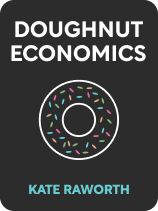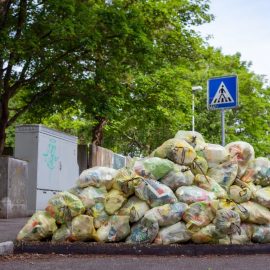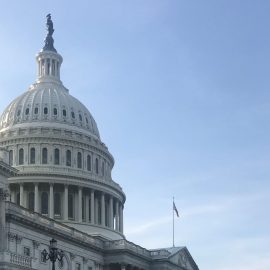

This article is an excerpt from the Shortform book guide to "Doughnut Economics" by Kate Raworth. Shortform has the world's best summaries and analyses of books you should be reading.
Like this article? Sign up for a free trial here .
What is the doughnut model in economics? How has economic growth pushed us outside the doughnut?
According to Kate Raworth, the author of Doughnut Economics, the goal of economic policy should be to stay within the inner ring of the metaphorical doughnut. This entails designing an economy that is productive enough to ensure that everyone on the planet has their basic material needs met, but that does not grow so fast as to deplete our natural resources and degrade the environment.
Here’s what we can do to stay within the doughnut, according to Raworth.
The Problem of Unchecked Growth
In her book Doughnut Economics, Kate Raworth reimagines the priorities of economic policy in terms of the doughnut model. The inner circle represents the zone of deprivation—an economy that does not produce enough of the necessary goods and services to sustain the population with adequate levels of food, shelter, health care, and other essential needs. The outer circle represents the limits of economic growth beyond which the economy begins to outstrip the planet’s natural resources, leading to devastating consequences like global warming and ocean acidification, which threaten life on Earth.
She writes that the economy must therefore stay within the bounds of the two circles, within the “dough” of the doughnut—growing enough to meet the full spectrum of human needs, but not so much that it outstrips the planet’s ability to provide the resources that make human civilization possible.
Raworth argues that unchecked economic growth has put us on the wrong side of both the doughnut rings. Despite progress, according to Raworth, we still have too much poverty, food insecurity, lack of opportunity, and other problems of deprivation. Markets may be extraordinarily efficient at distributing resources—through the invisible hand of supply and demand determining which goods are produced, in what quantities, at what price, and who ultimately receives them. However, left unchecked, they will also produce too many harmful by-products (like pollution and inequality) and too few social goods (like health care, education, and clean energy). Moreover, Raworth writes that we have pushed economic growth so far that some bad environmental outcomes may now be unavoidable.
(Shortform note: In The Deficit Myth, Stephanie Kelton similarly writes that our political system has chosen to focus inordinately on purely fiscal deficits (how much the government spends vs. how much revenue it brings in), but is largely unconcerned with social and human deficits—the lack of jobs, ]education, healthcare, and equality of opportunity that are imposing significant suffering on people. Kelton proposes a federal job guarantee to remake the economic order—having the federal government serve as an employer of last resort, guaranteeing the fundamental right to a job for anyone who wants one, and bringing important benefits to the economy and society as a whole.)
Staying Inside the Doughnut
Raworth writes that five factors will determine whether or not we stay within the doughnut (meeting everyone’s basic needs sustainably).
1. Population: The more of us there are, the more of the planet’s resources we’ll consume. Fortunately, Raworth notes, population growth has been falling thanks to improvements in health and well-being that empower women to control family size.
(Shortform note: In Factfulness, authors Hans Rosling, Ola Rosling, and Anna Rosling Rönnlund note that the worldwide average number of babies per woman has halved over the past 50 years, and the world population will settle between 10 billion and 12 billion by 2100. Like Raworth, they largely attribute this to falling family sizes as more of the population rises out of extreme poverty—giving women better access to contraception and creating less of a need to have children since they don’t need more hands for subsistence agriculture.)
2. Inequality: We need a more equitable distribution of what our planet and our economy produce. Raworth writes that problems like food insecurity are not borne of scarcity; they come from a wasteful, inefficient, and unjust spread of the planet’s bounty.
(Shortform note: The data supports Raworth’s assertion that the problems of deprivation are not the result of a lack of resources, but of an inequitable distribution of those resources. Although 270 million people across the world live in near-famine conditions, the planet’s agricultural base is capable of supplying 9 billion metric tons of food a year—2.4 times what it takes to feed every person on the planet.)
3. Vision: We need to have a clear vision of what we consider the necessities for every human being on the planet to lead a fulfilling and comfortable life. Part of the answer, Raworth suggests, may be a move away from rampant consumerism, which is often wasteful and largely exists to display our wealth to others in the form of conspicuous consumption.
(Shortform note: In The Happiness Hypothesis, author Jonathan Haidt argues that conspicuous consumption reduces human happiness by making us strive for the wrong things. When we buy a sports car or a piece of fancy jewelry to show it off to others, we’re engaging in an endless competitive cycle that only devalues the things we buy. Haidt writes that inconspicuous consumption, by contrast, is the kind of spending we do for our benefit, on things that make us intrinsically happy.)
4. Technology: Raworth writes that technologies that provide for social well-being while sustaining the environment—like green infrastructure, renewable energy, and sustainable agriculture—will be critical to our efforts to stay within the doughnut.
(Shortform note: In The Omnivore’s Dilemma, Michael Pollan writes that when it comes to supporting sustainable agriculture, consumers must choose between two alternatives to the corn-based industrial food chain—Big Organic and traditional organic. Big Organic is what supplies big companies like Whole Foods, Walmart, and supermarket chains. Like traditional organic, Big Organic operations avoid pesticides and synthetic fertilizer. But, Pollan warns, they’ve also adopted some practices of the industrial system including mass production, processing, and long-distance distribution. Traditional organic opposes processing and long-distance shipping and aims to sell its foods locally or regionally, while they are freshest.)
5. Government: We need governments at the local, national, and supranational levels to be agile, flexible, and responsive to society’s needs. This means focusing on the common good and sometimes sacrificing local or national concerns, while having the political courage to take on powerful special interests.
(Shortform note: In The Righteous Mind, Jonathan Haidt writes that this concern for the collective good is a facet of morality—and that it is highly culture-dependent. Westerners are individualistic, prioritizing individual rights over the common good. However, most societies subordinate the needs of the individual to the needs of the group—they are sociocentric. Thus, in an individualistic society, it may be more difficult for governments to convince citizens to sacrifice their personal priorities to meet society’s most pressing needs.)

———End of Preview———
Like what you just read? Read the rest of the world's best book summary and analysis of Kate Raworth's "Doughnut Economics" at Shortform .
Here's what you'll find in our full Doughnut Economics summary :
- Why we need a top-to-bottom redesign of our global economic order
- Why long-term economic growth is unsustainable
- How inequality fuels a feedback loop that leads to more inequality






